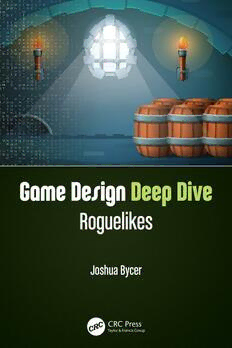
Game Design Deep Dive: Roguelikes PDF
Preview Game Design Deep Dive: Roguelikes
Game Design Deep Dive Game Design Deep Dive Roguelikes Joshua Bycer First edition published 2021 by CRC Press 6000 Broken Sound Parkway NW, Suite 300, Boca Raton, FL 33487-2742 and by CRC Press 2 Park Square, Milton Park, Abingdon, Oxon, OX14 4RN © 2021 Joshua Bycer CRC Press is an imprint of Taylor & Francis Group, LLC Te right of Joshua Bycer to be identifed as author[/s] of this work has been asserted by him in accordance with sections 77 and 78 of the Copyright, Designs and Patents Act 1988. Reasonable eforts have been made to publish reliable data and information, but the author and publisher cannot assume responsibility for the validity of all materials or the consequences of their use. Te authors and publishers have attempted to trace the copyright holders of all material reproduced in this publica- tion and apologize to copyright holders if permission to publish in this form has not been obtained. If any copyright material has not been acknowledged please write and let us know so we may rectify in any future reprint. Except as permitted under U.S. Copyright Law, no part of this book may be reprinted, reproduced, trans- mitted, or utilized in any form by any electronic, mechanical, or other means, now known or hereafer invented, including photocopying, microflming, and recording, or in any information storage or retrieval system, without written permission from the publishers. For permission to photocopy or use material electronically from this work, access www .copyright .com or contact the Copyright Clearance Center, Inc. (CCC), 222 Rosewood Drive, Danvers, MA 01923, 978-750- 8400. For works that are not available on CCC please contact mpkbookspermissions@ tandf. co. uk Trademark notice: Product or corporate names may be trademarks or registered trademarks and are used only for identifcation and explanation without intent to infringe. ISBN: 978-0-367-71371-3 (hbk) ISBN: 978-0-367-63819-1 (pbk) ISBN: 978-1-003-15053-4 (ebk) Typeset in Minion by Deanta Global Publishing Services, Chennai, India Dedication I would like to dedicate this book to my late grandfather Herbert Pousman, who died in 2015. He was always a supporter of my work and one of the kindest souls in my life. Unfortunately, he lef us before I became an author, and I could not share my book with him, and this is a small way of being able to honor him. Contents Preface ix Acknowledgments xi Author xiii 1 Introduction 1 2 The Birth of the Rogue 3 2.1 Early Rogues ................................................................................................3 2.2 What Is a Roguelike Like? .........................................................................4 3 Basic Roguelike Design 7 3.1 Turn-Based Design ....................................................................................7 3.2 Te Failure Loop .........................................................................................9 3.3 Replayable Gameplay ...............................................................................10 3.4 Te Appeal of “Hardcore” Mode ............................................................11 4 Off-Brand Roguelikes 13 4.1 Toejam and Earl ........................................................................................13 4.2 Mystery Dungeon Games ........................................................................14 4.3 Breath of Fire Dragon Quarter ................................................................15 4.4 Randomly Generated Games ..................................................................16 5 Generating Content 19 5.1 Random Generation ................................................................................ 20 5.2 Randomized Fairness ...............................................................................21 5.3 Procedural Generation ............................................................................ 24 5.4 Explaining Points of Interest ................................................................ 28 5.5 Random vs. Procedural Generation? .................................................... 29 vii 6 Advanced Roguelike Design 31 6.1 Creating Variance .....................................................................................32 6.2 Categories of Content ...............................................................................33 6.3 Structuring Your Content .......................................................................35 6.4 Supplemental Content ..............................................................................37 6.5 Randomized Balance ............................................................................... 39 6.6 Persistence Systems...................................................................................41 7 The Roguelike Rises 45 7.1 Spelunky..................................................................................................... 46 7.2 Te Binding of Isaac ................................................................................. 46 7.3 Dungeons of Dredmor .............................................................................. 48 7.4 Te Indie Boom ........................................................................................ 49 7.5 Deck-Building Roguelike Design ...........................................................52 7.6 Defning a Roguelike ................................................................................55 8 AAA Roguelikes 57 8.1 Demon’s Souls ........................................................................................... 58 8.2 “Soulslike” Design ....................................................................................59 8.3 Prey Mooncrash .........................................................................................61 9 The Roguelike Confusion 63 9.1 Te Roguelike Debate ............................................................................. 64 9.2 Roguelite vs. Roguelike ........................................................................... 64 9.3 Action Roguelike ..................................................................................... 67 9.4 Te Shades of a Rogue ............................................................................. 68 10 Expert Roguelike Design 71 10.1 Getting the Basics Right ......................................................................... 72 10.2 Proper Pacing ............................................................................................74 10.3 Open-World Roguelike Design ...............................................................76 10.4 Te Focal Points of Replayability .......................................................... 79 10.5 Te Dangers of Fixed Content ............................................................... 82 10.6 Debunking “Infnite Replayability” ...................................................... 85 10.7 Balancing the Unpredictable .................................................................. 87 10.8 Progressive Difculty .............................................................................. 90 10.9 Narrative Roguelikes ............................................................................... 94 Conclusion 97 Glossary 99 Index 103 viii Contents Preface Welcome to my second book in the Game Design Deep Dive series. When I started this with Game Design Deep Dive: Platformers (Taylor & Francis, 2020), I pur- posely chose the most recognizable and long-lasting genre in the game industry. For this entry, we are going to examine a genre that had remained a niche sensation for over 30 years. Roguelike design presents a rich canvas for designers to play around with, leading to even arguments over the genre defnitions. Tis is a genre that has as much potential as it does pitfalls for designers that do not understand its quirks. Te last decade saw the genre and its design philosophy become one of the most popular examples of games, besides platformers, for indie developers to make. In that same span of time, developers have experimented with roguelike elements in other genres to create totally unique designs. Another reason I wanted to write about roguelikes is the use of procedural and random generation and to clear up misconceptions about the practice. Being able to create a game that can design content is one of the hardest aspects of game design, and there are not enough formal discussions about it. Writing this book gave me a chance to focus the last decade of thinking about roguelikes into a single source, and I hope this will provide some useful knowl- edge for new and existing developers. As always, please let me know what you think either on Twitter @GWBycer or at josh@ game- wisdom. c om. ix
